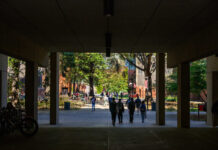James Ramsey, president, University of Louisville
The Thinker is an iconic symbol for the University of Louisville. That’s obvious. But The Thinker is more than that. The image of a man pondering, thinking and exercising his brain is exactly what we want visitors to see when they visit UofL, either on the steps of Grawemeyer Hall or at a table in the library. After all, this is a place of higher learning. And having a Rodin sitting at the gateway to our great university is also an expression of our appreciation for the arts. This gem can be viewed by the public, 365 days a year without an admission fee, and complements the other artistic pieces and places on our campus such as the Truth and Justice statue, the Hite Art Institute and, of course, the famous Speed Art Museum. We couldn’t be happier that The Thinker is back at his post, all cleaned up and ready for another 100 years of service.
Christopher Fulton, associate professor, art historian
The Thinker is an amazing sculpture because it is an image of the intensive process of thinking, of a human being thinking and of all humanity thinking. And that image, that idea, takes on different meanings in different locations. This is one of the wonderful things about The Thinker. Its meaning is open-ended, open to different interpretations, depending upon the site at which it is shown. For example, on the Gates (of Hell, the original commission), The Thinker is the creator, the visionary, who has an inward view of the hellish scene.
When Rodin died in 1917, he instructed his heirs to place a copy of the statue over his own grave, and there it takes on a certain value of contemplating death —or maybe life. And then a few years ago, the Paris version of The Thinker was taken to Berlin and exhibited in front of the Brandenburg Gates where it might be construed as an image of humankind reflecting on German history and the division of Germany and its recent unification, thinking about this troubled past.
At our own institution, it’s placed in front of Grawemeyer Hall, where it stands as an emblem, as I see it, of the university itself as an institution dedicated to thinking, inciting students and faculty, as well, to work intently, to concentrate, to use every particle of their body to produce original thought and to create—as Rodin conceived of the figure thinking and creating at the same time.
So the wonderful thing about the sculpture is that it is a potent symbol whose meaning is inflected differently at different locations.
Dario Covi, UofL professor emeritus, fine arts
I first saw Rodin’s bronze statue of The Thinker mounted on a stone base before the front steps of the Administration Building (now known as Grawemeyer Hall) in 1956. At once it appealed to me both for its large scale and for the pose of a person in deep thought. It never failed to move me as a most expressive monument. Now expertly restored and mounted on a newly carved stone base, it appeals to me exactly as Rodin himself would have wanted. Rodin is quoted* as saying in an interview with a Canadian newspaper reporter shortly before his death that ‘Nature gives me my model, life and thought,’ adding, that ‘What makes my Thinker think is that he thinks not only with his brain, with his knitted brow, his distended nostrils and compressed lips, but with every muscle of his arms, back and legs, with his clenched fist and gripping toes.’ Now, fully restored, seen from close up, even the smallest details speak to us of the arduous nature of thinking. (*Elbert E. Elsen, “Rodin,” The Museum of Modern Art, 1963, p. 52)
John Begley, director of the Hite Art Institute galleries
What better sort of symbol for an academic institution, a university. There’s the body and the mind and the spirit all there with the buildings and the lawn. It’s really just a wonderful symbol that ties in both an academic and intellectual seriousness with a sort of spiritual kind of man contemplating the future. What should a university do other than think of those things. We’re just absolutely fortunate. You know we took it for granted. It’s there. It’s The Thinker, our Thinker. And I think that’s as it should be. But we also have to take care of it. I mean it’s not just ours—it’s the world’s—and it’s our responsibility to treat it right.
Andrew Lins, Neubauer family chair of conservation at the Philadelphia Museum of Art
I work at a museum in Philadelphia that has the first and largest collection of Rodin material in the U.S. While I’ve worked on The Thinker, the Louisville version is unique. It’s very interesting to me to be able to see this up close and deal with the challenges that it poses for conservation, but also how it differs from the later castings that I’m more familiar with. So for me, this is a great instructive work that we’re doing for the university.


























